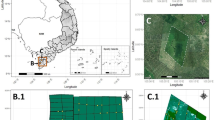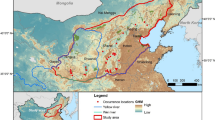We surveyed slender lorises (Loris lydekkerianus) in Karnataka, south India intermittently during November 2001–July 2004 and estimated their relative abundance via direct sightings. Two subspecies, Loris lydekkerianus lydekkerianus and L. l. malabaricus, with different morphological traits, occur in the eastern drier region and the western wet region of the state, respectively. The distribution of Loris lydekkerianus lydekkerianus is patchy in a small region in the southeast, which contradicts earlier reports of its abundance throughout the state. Loris lydekkerianus malabaricus occurs throughout the Western Ghats as a contiguous population. The encounter rates of Loris lydekkerianus lydekkerianus and L. l. malabaricus are 0.41 individuals/km and 0.21 individuals/km, respectively. Whereas several forest tracts in the distributional range of Loris lydekkerianus malabaricus are protected areas, no such area exists in the distributional range of L. l. lydekkerianus. Loris lydekkerianus faces serious challenges of conservation because it largely occurs in commercial plantations, which can be relatively unstable habitats as harvesting can take place at any time.






Similar content being viewed by others
Notes
A taluk is a revenue administrative unit with a defined boundary and an area of about 1000 km2.
REFERENCES
Baillie, J. E. M., Hilton-Taylor, C., and Stuart, S. N. (2004). 2004 IUCN Red List of Threatened Species: A Global Species Assessment. IUCN World Conservation Union, Cambridge.
Blanford, W. T. (1888). Fauna of British India, Mammals. Taylor & Frances, London, p. 47.
Devaraj Sarkar, H. B., Murali, S., Prasad, D. T., Shekarappa, B. M., and Vijayalakshmi, V. (1981). The population and distribution of the slender loris (Loris tardigradus) in Karnataka State. Tigerpaper 8: 7–10.
Fiedler, W. (1956). Übersicht über das system der primaten. In Hofer, H., Schulze, A. H., and Starck, D. (eds.), Primatologia, Basel, Karger, Vol. I, pp. 1–266.
Groves, C. P. (2001). Primate Taxonomy. Smithsonian Institution Press, Washington, DC, p. 350.
Jenkins, P. D. (1987). Catalogue of Primates in the British Museum (Natural History). Part IV: Suborder Strepsirrhini. British Museum (Natural History), London.
Johnson, J. M. (1984). Diurnal activities of the slender loris, Loris tardigradus, in the Mundanthurai Sanctuary, Tamil Nadu (India). In Roonwal, M. L., Mohnot, S. M., and Rathore, N. S. (eds.), Current Primate Researches. University of Jodhpur Press, Jodhpur, India, pp. 389–395.
Jungers, W. L. (1985). Body size and scaling of limb proportions in primates. In Jungers, W. L. (ed.), Size and Scaling in Primate Biology. Plenum Press, New York, pp. 345–381.
Karanth, K. U. (1986). Status of wildlife and habitat conservation in Karnataka. J. Bombay Nat. Hist. Soc. 83(Suppl): 166–179.
Kar-Gupta, K. (1998). Ecology and conservation of the slender loris (Loris tardigradus malabaricus): Preliminary results from a long term study. Congr. Int. Primatol. Soc. Abstr. 17.
Kumar, M. A., Singh, M., Srivastava, S., Udhayan, A., Kumara, H. N., and Sharma, A. K. (2002). Distribution and management of wild mammals in Indira Gandhi Wildlife Sanctuary, Tamilnadu, India. J. Bombay Nat. Hist. Soc. 99: 184–210.
Kumara, H. N., Kumar, S., and Singh, M. (2005). A novel foraging technique observed in slender loris (Loris lydekkerianus malabaricus) feeding on red ants in the Western Ghats, India. Folia Primatol. 76: 116–118.
Kumara, H. N., and Singh, M. (2004a). Distribution of primates and conservation of Macaca silenus in rainforests of the Western Ghats, Karnataka, India. Int. J. Primatol. 25: 1001–1018.
Kumara, H. N., and Singh, M. (2004b). The influence of differing hunting practices on the relative abundance of mammals in two rainforest areas of the Western Ghats, India. Oryx 38: 321–327.
Lakshmi, B. B., and Mohan, B. A. (2002). Behavioural ecology, distribution and status of Loris tardigradus (slender loris) in Andhra Pradesh. J. Nat. Conserv. 14: 27–31.
Manjula, A. (1984). Changes in levels of proteins in the male reproductive system of the slender loris, Loris tardigradus lydekkerianus. In Roonwal, M. L., Mohnot, S. M., and Rathore, N. S. (eds.), Current Primate Researches. University of Jodhpur Press, Jodhpur, India, pp. 441–447.
Nekaris, K. A. I. (2001). Activity budget and positional behaviour of the Mysore slender loris: Implications for slow climbing locomotion. Folia Primatol. 72: 228–241.
Nekaris, K. A. I (2003). Spacing system of the Mysore slender loris (Loris lydekkerianus lydekkerianus). Am. J. Phys. Anthropol. 121: 86–96.
Osman Hill, W. C. (1933). A monograph on the genus Loris, with an account of the external, cranial and dental characters of the genus: A revision of the known forms, and the description of a new form from northern Ceylon. Ceylon J. Sci. (Colombo) B 18: 89–132.
Osman Hill, W. C. (1953). Primates: Comparative Anatomy and Taxonomy, Vol. I: Strepsirrhini, Edinburgh University Press, Edinburgh.
Pascal, J. P. (1988). Wet Evergreen Forests of the Western Ghats of India. Institut Francais De Pondicherry, Pondicherry, India, p. 345.
Prasad, S. N., Nair, V. P., Sharathchandra, H. C., and Gadgil, M. (1978). On factors Governing the distribution of wild mammals in Karnataka. J. Bombay Nat. Hist. Soc. 75: 718– 743.
Radhakrishna, S., and Singh, M. (2002a). Home range and ranging pattern in the slender loris (Loris tardigradus lydekkerianus). Primates 43: 237–248.
Radhakrishna, S., and Singh, M. (2002b). Social behavior of slender loris (Loris tardigradus lydekkerianus). Folia Primatol. 73: 181–196.
Radhakrishna, S., and Singh, M. (2002c). Activity schedule and habitat use of slender loris (Loris tardigradus lydekkerianus). J. Bombay Nat. Hist. Soc. 99: 400–407.
Radhakrishna, S., and Singh, M. (2004a). Reproductive biology of the slender loris (Loris lydekkerianus lydekkerianus). Folia Primatol. 75: 1–13.
Radhakrishna, S., and Singh, M. (2004b). Infant development in the slender loris (Loris lydekkerianus lydekkerianus). Curr. Sci. 86: 1121–1127.
Rai, N. D., and Kumar, A. (1993). A pilot study on the conservation of the Malabar civet, Viverra civettina (Blyth, 1862): Project report. Small Carniv. Conserv. 9: 3–7.
Ramakrishna, P. A., and Prasad, M. R. N. (1967). Changes in the male reproductive organs of loris tardigradus lydekkerianus (Cabrera). Folia Primatol. 5: 176–189.
Ramaswami, L. A., and Kumar, T. C. A. (1962). Reproductive cycle of the slender loris. Naturwissenschaften 49: 115–116.
Ramaswami, L. A., and Kumar, T. C. A. (1965). Some aspects of reproduction of the female slender loris, Loris tardigradus lydekkerianus (cabr). Acta Zool. 46: 257–273.
Rao, P. (1994). Occurrence of the slender loris Loris tardigradus in South Coastal Andhra Pradesh, India. J. Bombay Nat. Hist. Soc. 91: 303.
Roonwal, M. L., and Mohnot, S. M. (1977). Primates of South Asia: Ecology, Sociobiology and Behavior. Harvard University Press, Cambridge.
Ryley, K. V. (1913). Mammal survey of India—L. lydekkerianus, Cabrera. The Mysore slender loris. J. Bombay Nat. Hist. Soc. 22: 283–287.
Sarma, R., and Kadam, M. (1984). Study of germ-cell morphology and the spermatogenic cycle in the slender loris, Loris tardigradus lydekkerianus (Cabr.). In Roonwal, M. L., Mohnot, S. M., and Rathore, N. S. (eds.), Current Primate Researches. University of Jodhpur Press, Jodhpur, India, pp. 167–175.
Schulze, H., and Meier, B. (1995). The subspecies of Loris tardigradus and their conservation status: A review. In Alterman, L., Doyle, G. A., and Izard, M. K. (eds.), Creatures of the Dark: The Nocturnal Prosimians. Plenum Press, New York, pp. 193–210.
Schulze, H., Nekaris, K. A. I., Fitch-Snyder, H., Plesker, R., Streicher, U., and Vornefield, B. (2004). Conservation database for lorises and pottos, chapter: Health database, in http://www.loris-conservation.org/database/, accessed on March 14, 2005.
Schulze, H., Ramanathan, A., Fitch-Snyder, H., Nekaris, K. A. I., Singh, M., and Kaumanns, W. (2005). Care of rescued south Indian lorises with guidelines for hand-rearing infants. In Menon, V., Ashraf, N. V. K., Panda, P., and Mainkar, K. (eds.), Back to the Wild: Studies in Wildlife Rehabilitation. Wildlife Trust of India, New Delhi, pp. 104–118.
Seth, P. K. (1963). Preliminary observations on slender lorises. Anthropologist 7: 45–51.
Singh, M., Kumar, M. A., Kumara, H. N., and Mohnot, S. M. (2000). Distribution and conservation of slender lorises (Loris tardigradus lydekkerianus) in southern Andhra Pradesh, South India. Int. J. Primatol. 21: 721–730.
Singh, M., Lindburg, D. G., Udhayan, A., Kumar, M. A., and Kumara, H. N. (1999). Status survey of slender loris Loris tardigradus lydekkerianus in Dindigul, Tamil Nadu, India. Oryx 33: 31–37.
Sokal, R. R. and Rohlf, F. J. (1995). Biometry. W. H. Freeman, New York.
Swayamprabha, M. S. (1983). Studies on the Physiological and Biochemical Relations Between the Ovary and the Reproductive Tract in the Female Slender Loris Loris tardigradus lydekkerianus, Ph.D. Thesis, Bangalore University, India.
Swayamprabha, M. S., and Kadam, K. M. (1980). Mother-infant relationship in the slender loris (Loris tardigradus lydekkerianus). Primates 21: 561–566.
Wroughton, R. C. (1917). The slender loris of Malabar. J. Bombay Nat. Hist. Soc. XXV: 45.
ACKNOWLEDGMENTS
The Department of Science and Technology, Government of India (grant no. SP/SO/C-16/99) sponsored the study. We thank the Chief Wildlife Warden and the officials of the Karnataka Forest Department for permission to carry out the study and also for assistance in the field. We thank Helga Schulze for discussion on the distribution patterns. We acknowledge the support of Mridula Singh, M.S. Chaitra, B.K. Sharath, A.K. Sharma, M. Ananda Kumar, Kushalappa, Raghunath Rao, and N.A. Madhyastha. Reviewers’ comments by reviewers were extremely helpful in improving the quality of the article.
Author information
Authors and Affiliations
Corresponding author
Rights and permissions
About this article
Cite this article
Kumara, H.N., Singh, M. & Kumar, S. Distribution, Habitat Correlates, and Conservation of Loris lydekkerianus in Karnataka, India. Int J Primatol 27, 941–969 (2006). https://doi.org/10.1007/s10764-006-9054-z
Received:
Revised:
Accepted:
Published:
Issue Date:
DOI: https://doi.org/10.1007/s10764-006-9054-z




